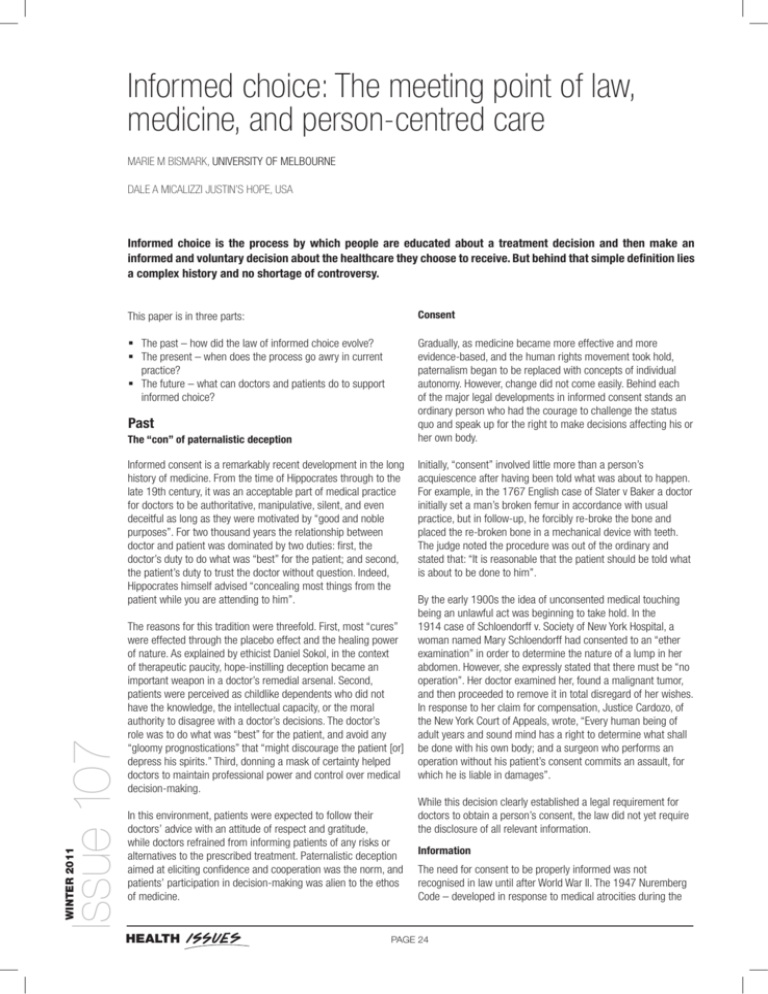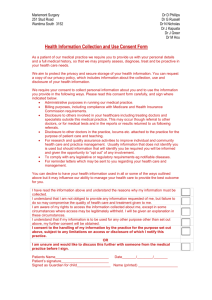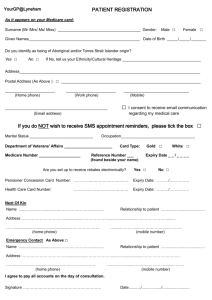here - The Task Force for Global Health
advertisement

Informed choice: The meeting point of law, medicine, and person-centred care MARIE M BISMARK, UNIVERSITY OF MELBOURNE DALE A MICALIZZI JUSTIN’S HOPE, USA Informed choice is the process by which people are educated about a treatment decision and then make an informed and voluntary decision about the healthcare they choose to receive. But behind that simple definition lies a complex history and no shortage of controversy. This paper is in three parts: Consent ß The past – how did the law of informed choice evolve? ß The present – when does the process go awry in current practice? ß The future – what can doctors and patients do to support informed choice? Gradually, as medicine became more effective and more evidence-based, and the human rights movement took hold, paternalism began to be replaced with concepts of individual autonomy. However, change did not come easily. Behind each of the major legal developments in informed consent stands an ordinary person who had the courage to challenge the status quo and speak up for the right to make decisions affecting his or her own body. Past The “con” of paternalistic deception WINTER 2011 Issue 107 Informed consent is a remarkably recent development in the long history of medicine. From the time of Hippocrates through to the late 19th century, it was an acceptable part of medical practice for doctors to be authoritative, manipulative, silent, and even deceitful as long as they were motivated by “good and noble purposes”. For two thousand years the relationship between doctor and patient was dominated by two duties: first, the doctor’s duty to do what was “best” for the patient; and second, the patient’s duty to trust the doctor without question. Indeed, Hippocrates himself advised “concealing most things from the patient while you are attending to him”. The reasons for this tradition were threefold. First, most “cures” were effected through the placebo effect and the healing power of nature. As explained by ethicist Daniel Sokol, in the context of therapeutic paucity, hope-instilling deception became an important weapon in a doctor’s remedial arsenal. Second, patients were perceived as childlike dependents who did not have the knowledge, the intellectual capacity, or the moral authority to disagree with a doctor’s decisions. The doctor’s role was to do what was “best” for the patient, and avoid any “gloomy prognostications” that “might discourage the patient [or] depress his spirits.” Third, donning a mask of certainty helped doctors to maintain professional power and control over medical decision-making. In this environment, patients were expected to follow their doctors’ advice with an attitude of respect and gratitude, while doctors refrained from informing patients of any risks or alternatives to the prescribed treatment. Paternalistic deception aimed at eliciting confidence and cooperation was the norm, and patients’ participation in decision-making was alien to the ethos of medicine. HEALTH Initially, “consent” involved little more than a person’s acquiescence after having been told what was about to happen. For example, in the 1767 English case of Slater v Baker a doctor initially set a man’s broken femur in accordance with usual practice, but in follow-up, he forcibly re-broke the bone and placed the re-broken bone in a mechanical device with teeth. The judge noted the procedure was out of the ordinary and stated that: “It is reasonable that the patient should be told what is about to be done to him”. By the early 1900s the idea of unconsented medical touching being an unlawful act was beginning to take hold. In the 1914 case of Schloendorff v. Society of New York Hospital, a woman named Mary Schloendorff had consented to an “ether examination” in order to determine the nature of a lump in her abdomen. However, she expressly stated that there must be “no operation”. Her doctor examined her, found a malignant tumor, and then proceeded to remove it in total disregard of her wishes. In response to her claim for compensation, Justice Cardozo, of the New York Court of Appeals, wrote, “Every human being of adult years and sound mind has a right to determine what shall be done with his own body; and a surgeon who performs an operation without his patient’s consent commits an assault, for which he is liable in damages”. While this decision clearly established a legal requirement for doctors to obtain a person’s consent, the law did not yet require the disclosure of all relevant information. Information The need for consent to be properly informed was not recognised in law until after World War II. The 1947 Nuremberg Code – developed in response to medical atrocities during the PAGE 24 In 1972, a radical development in consent law occurred in the United States. The case of Canterbury v Spence introduced for the first time a patient-centred standard for informed consent. Nineteen-year-old Mr Canterbury was a typist for the FBI. He suffered from back pain, and his surgeon recommended spinal surgery. Postoperatively, he was left incontinent and unable to walk unaided – a devastating outcome for a previously healthy teenager. The judge held that “The patient’s right of self decision ... can be effectively exercised only if the patient possesses enough information to enable an intelligent choice. The scope of the physician’s communications ... must be measured by the patient’s need.” This patient-centred approach was subsequently adopted in Australia in the case of Rogers v Whitaker. Maree Whitaker lost sight in her right eye through an eye injury at the age of nine. Prior to surgery on her blind eye, she asked several times if there was anything that could go wrong and was reassured that no serious complications were associated with the surgery. Unfortunately, she developed sympathetic ophthalmitis in her good left eye and was left almost totally blind. The High Court judges agreed that the risk of total blindness, no matter how small, was material to her decision and it was negligent not to advise her of that risk. As in the case of Canterbury v Spence, the test of “materiality” in Rogers v Whittaker was clearly patient-centred: “a risk is material if, in the circumstances of the particular case, a reasonable person in the patient’s position, if warned of the risk, would be likely to attach significance to it”. Present Over the four decades that have passed since Canterbury v Spence, the requirement for informed consent has become firmly entrenched in law and is now explicitly specified in most codes of good practice for health professionals. (Although in some jurisdictions the tussle between patient-centred and doctor-centred standards of disclosure continues.) However, despite an outpouring of medical, ethical, and legal writing on informed consent, there remains remarkably little empirical information on how the process actually functions in clinical practice, including the circumstances in which informed consent goes awry. We do know that many informed consent procedures have developed to protect the interests of health practitioners, and protect them from medico-legal risk, rather than meet the needs of patients and their families. In many healthcare settings there has been an emphasis on documentation to the detriment of good quality decision-making. Many informed consent documents are legalistic, vague and uninformative. For a patient or family member who is already feeling frightened and vulnerable, quickly signing and pushing the form away may feel safer than struggling to work through language and concepts that they are ill-equipped to understand. In the United States, research has found that fewer than 20% of patients have the literacy skills required to understand typical informed consent materials. It is therefore unsurprising that within a day of signing an informed consent form nearly half of patients cannot recall the exact nature of the planned operation nor correctly list the major risks. Indeed, many patients believe that consent forms are meant to “protect the physician’s rights.” Instead of fostering a dialogue between the doctor and patient, the informed consent process can potentially interfere with the relationship if the focus is placed on completion of forms and decreasing legal liability. Internationally, there is significant variation in the extent to which people are informed about and involved in decisions regarding their own healthcare. In Japan, for example, some doctors continue to hold the view that patients should not be informed of an incurable cancer diagnosis, or at least not until their family members have been informed and agreed to such a disclosure. In contrast, New Zealand actively promotes and protects patients’ rights to effective communication, open and honest information, and an informed choice through a Code of Health and Disability Services Consumers’ Rights which is enforced in law by a Health Commissioner. Perhaps it is no coincidence that, in a 2007 international survey by the Commonwealth Fund, New Zealand ranked number one for patient-centred care and patient involvement in treatment decisions. Medico-legal information Medico-legal data provide a valuable window into situations where the informed consent process goes awry. A review of nearly 500 litigation and complaint files in Australia, conducted by the Law and Public Health group at the University of Melbourne, found that 1 in 30 malpractice claims and 1 in 9 conciliated complaints alleged problems with informed consent. Full findings from this study will be available through the Medical Journal of Australia (http://www.mja.com.au/). Over ninety per cent of the informed consent cases involved surgical procedures, with plastic surgeons, orthopaedic surgeons, and vascular surgeons at particularly high risk. Around three-quarters of the cases centred on the allegation that certain complications, which ultimately affected the patient, were not mentioned or properly explained prior to the treatment. These findings clearly indicate that concerns about surgical risks not properly explained are the heartland of contemporary disputes PAGE 25 HEALTH Issue 107 The term “informed consent” was coined a decade later in the 1957 case of Salgo v. Leland Stanford Jr. University Board of Trustees. As a result of an investigation for leg cramps, Martin Salgo was left paralysed below his waist. The California Court found that patients are “entitled to the full disclosure of facts necessary to an informed consent”, though in a nod back to medicine’s more paternalistic roots, the court allowed that “a certain amount of discretion must be employed” in deciding which risks to disclose. Not just a signature on a form WINTER 2011 Holocaust - emphasised that research could only be carried out if a participant consented after receiving sufficient information about “the nature, duration, and purpose” of the procedure and “all inconveniences and hazards reasonably to be expected”. uncertainties. Such openness is not an admission of weakness, but rather a sign of strength and trustworthiness. In the words of Laurence Peter: “Some problems are so complex that you have to be highly intelligent and wellinformed just to be undecided about them.” Impossible promises – even implicit ones – leave people with a sense of distrust that is difficult to reverse. over informed consent, at least in Australia. By contrast, other types of breakdowns in the informed consent process that have attracted intense scholarly attention (such as failure to adequately assess patient competence) appear to be infrequent triggers of formal disputes. The study also found that disputes over informed consent almost never involve isolated “dignitary harms”. Informed consent concerns are usually fellow travellers with concerns that the episode of care was substandard in other ways. Worryingly, a number of surgeons in the study continued to justify their failure to disclose risks on the grounds that the patient clearly needed the operation, the doctor knew best, and disclosing the risk would simply have worried the patient or dissuaded him or her from having the surgery. So much for individual autonomy! “What does this mean for me and my family?” Future Medicine Fifty years of informed consent laws have not fully reformed doctor–patient communications, so it is unlikely that these brief comments will have much of an impact on medical practice. But, for what they are worth, our four key recommendations for doctors are as follows: WINTER 2011 Issue 107 1) Get the basics right: For ethical, legal, and clinical reasons it is important to obtain consent and to be able to show that such consent was obtained. However, doctors’ medico-legal anxieties are often directed towards issues which are rarely, if ever, the substance of a lawsuit or complaint. Our research suggests that most lawsuits and complaints arise from a simple failure to “get the basics right”: failure to devote enough time to important conversations; failure to address patients’ and families’ fears and concerns; failure to disclose serious known risks of surgery; and failure to document discussions. Many doctors would do well to stop worrying so much about the medico-legal risks of informed choice and start thinking more about clear and open communication. 2) Aim for dialogue not monologue: An informed choice requires a two-way conversation about doctors’ hopes, doubts and expectations and patients’ and families’ wishes and fears. Moving away from the paternalistic past and toward the shared responsibilities of participatory medicine requires a willingness to adopt a wide range of communication methods – extended discussions, personalised information sheets, multimedia programs, and feedback techniques – so that people can more fully understand options and incorporate their own values and preferences into the decision. Such approaches may initially seem time-consuming and expensive, but the time costs are much less than the costs of unwanted interventions or unanticipated complications. 3) Understand that trust is built on honesty not infallibility. From the perspective of many patients and families, the best doctors are often those who have given up the mask of certitude in order to truthfully acknowledge medical HEALTH 4) Commit to open disclosure of any risks that do occur. Warning people of all the significant risks that might arise before they choose to accept a certain treatment or procedure is only the first step in an ongoing process. Equally important is a commitment to openly disclose any risks that actually do materialise during or after a treatment or procedure. We would encourage doctors to commit to the timely and truthful disclosure of any subsequent adverse events as a standard part of the informed choice process. And finally we turn to the question of most importance to patients and families as they negotiate complex healthcare systems: “What does this mean for me (or my family member)?” We suggest three ways in which consumers can improve the process of informed choice. 1) Speak up about your concerns, questions, and what’s important to you: In order to be enabled, empowered and engaged you need to understand the choices before you. It is quite reasonable to ask – not just about general risks – but about how those risks might apply in your own personal situation. How much experience has your doctor had with this type of procedure? How does your individual risk differ from the general population? How would you fare with a less invasive alternative to a given surgical procedure? 2) Seek and use high-quality health information: There is a wealth of health information available online (some sites are more accurate and accessible than others) and through patient and family support groups which can help you to understand the available options, and how they might interface with your views, values, and preferences. For those of you who haven’t seen it yet, we highly recommend e-patient Dave’s “Let Patients Help” talk (www.ted.com/talks/ dave_debronkart_meet_e_patient_dave.html) as an example of the extraordinary impact that personal data and high quality information can have on a person’s health choices. 3) Recognise that you have a right to partnership in decisionmaking: During every healthcare encounter it is worth remembering that two thousand years of medical tradition have encouraged doctors to offer certainty and reassurance, and to withdraw behind a curtain of silence rather than discuss doubts and concerns. But the reality is that technical issues are only some of the determinants that impinge on healthcare choices. How can a doctor act “for your own good” unless you both understand what your own personal “good” might be? So speak up, speak out, and aspire for not just informed consent, but informed choice. PAGE 26 Acknowledgements WINTER 2011 Issue 107 We acknowledge the contribution of David Studdert and other members of the University Law and Public Health Group. We thank Beth Wilson, the Health Services Commissioner of Victoria, and Avant for supporting research into informed choice in Australia. We are also grateful to Dave de Bronkart, Regina Holliday, Helen Haskell, and all of the other patients, families and health practitioners who contributed their ideas towards this paper. PAGE 27 HEALTH








